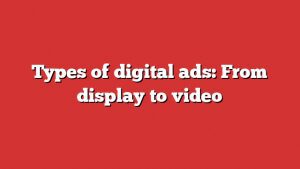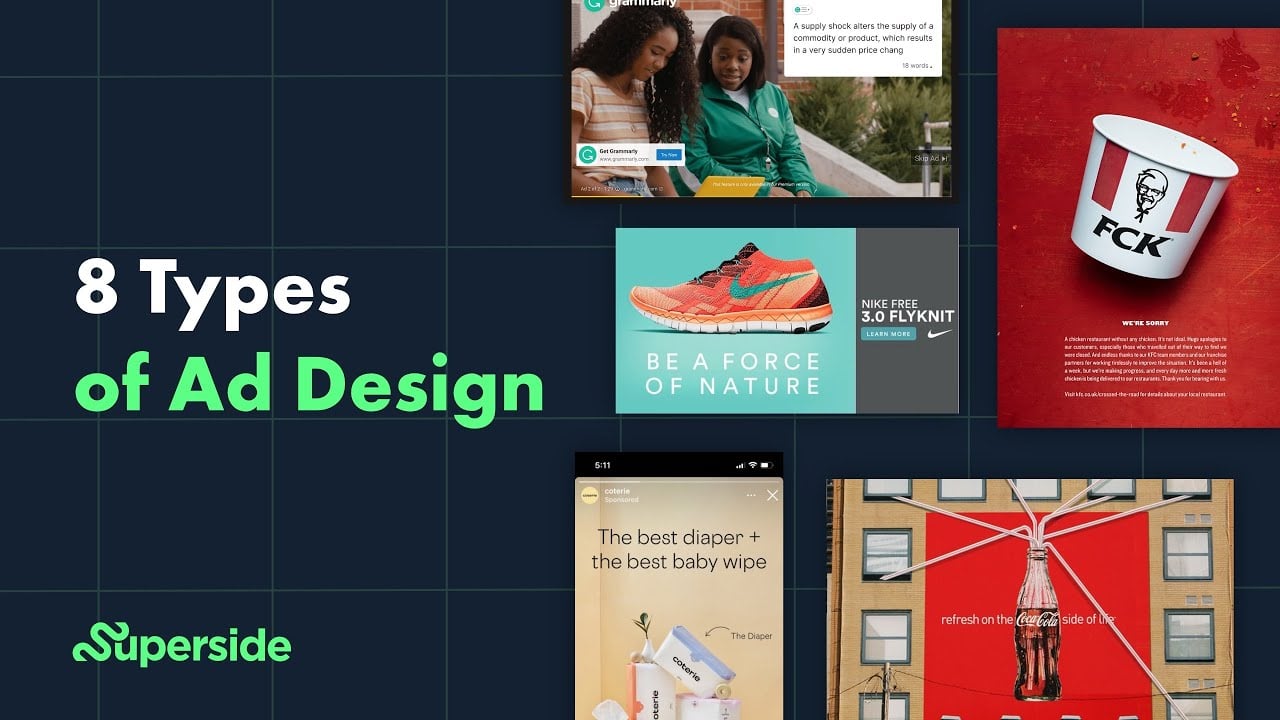In a rapidly evolving digital landscape, advertising has taken on countless innovative forms.
From eye-catching displayads to persuasive video campaigns, each type of digital ad has its own unique charm and purpose.
Join us as we dive into the fascinating world of advertising, exploring the endless possibilities that encompass display, PPC, mobile, retargeting, video, social media, native, paid search, influencer, and audio ads.
Get ready to be captivated by the vast realm of digital advertising, and discover the strategies that make each type truly shine.
Table of Contents
types of digital ads
There are several types of digital ads, including display advertising, PPC ads, mobile-specific ads, retargeting/remarketing ads, video advertising, social media ads, native advertising, paid search advertising, influencer advertising, and audio advertising.Key Points:
- Various types of digital ads include:
- Display advertising
- PPC ads
- Mobile-specific ads
- Retargeting/remarketing ads
- Video advertising
Social media ads
Additionally, there are:
- Native advertising
- Paid search advertising
- Influencer advertising
Audio advertising
Digital display ads are visual ads that can appear on:
- Websites
- Mobile apps
Social media platforms
PPC (Pay-Per-Click) ads are a form of paid advertising where advertisers pay a fee each time their ad is clicked.
Mobile-specific ads are designed specifically for mobile devices and are optimized for a better user experience on smaller screens.
Retargeting/remarketing ads are shown to users who have previously visited a website or engaged with a brand, aiming to re-engage and encourage conversion.
Check this out:
💡 Did You Know?
1. Native ads, a type of digital ad, were first introduced by Yahoo in 2012 as a way to seamlessly integrate promotional content into a website’s design, making it appear more like editorial content.
2. The term “banner blindness” refers to the phenomenon where internet users consciously or subconsciously ignore banner ads, leading advertisers to explore new formats like native ads and video ads to capture user attention.
3. Rich media ads, which include interactive elements such as video, audio, or animations, were first introduced in the late 1990s and have significantly enhanced user engagement with digital advertising.
4. Remarketing ads, also known as retargeting ads, utilize cookie technology to display targeted advertising to website visitors who have previously interacted with a specific brand’s website or products.
5. Facebook offers a specific type of ad known as a “carousel ad,” which allows advertisers to include multiple images or videos within a single ad unit, enabling them to showcase various products or features in a dynamic and interactive format.
Display Advertising
Display advertising is a prominent form of online advertising that utilizes visual elements such as images, banners, and videos to communicate a marketing message. These ads can be found on various websites, blogs, and social media platforms.
Display ads aim to capture the attention of the target audience and drive them to take a specific action, such as visiting a website or making a purchase.
Key advantages of display advertising:
- Versatility: Advertisers have the flexibility to choose from different formats, such as static images, animated banners, or interactive videos, depending on their campaign goals and target audience preferences.
- Advanced targeting: Advertisers can leverage advanced targeting techniques to ensure their ads reach the right people at the right time, increasing the chances of conversion.
- Rich media formats: Display ads offer rich media formats that can be optimized for different devices, including desktop computers, tablets, and smartphones. This adaptability ensures that the ads maintain their visual appeal and effectiveness across multiple platforms, thereby maximizing the reach and impact of the campaign.
Display advertising is a powerful tool for businesses to create visually appealing and impactful ad campaigns. By utilizing various formats and targeting techniques, advertisers can effectively engage their target audience and drive them towards desired actions.
Fresh tips added for advertisers this week.
- Increased brand visibility
- Enhanced audience engagement
- Improved conversion rates
PPC Ads
Pay-per-click (PPC) ads, also known as cost-per-click (CPC) ads, are a popular form of online advertising where advertisers pay a fee each time their ad is clicked. PPC ads are typically displayed on search engine results pages (SERPs) and industry-relevant websites. This allows businesses to position their ads prominently and drive targeted traffic to their websites.
One of the primary advantages of PPC ads is that advertisers only pay when their ad is clicked. This reduces the risk of wasted ad spend and ensures businesses are charged for actual engagement. In addition, PPC ads offer precise targeting options, enabling advertisers to reach specific demographics, geographic locations, and interests. This ensures that the ads are shown to the most relevant audience who are likely to be interested in their products or services.
To optimize the effectiveness of PPC ads, advertisers can employ keyword research to target relevant search queries. By bidding on specific keywords, advertisers can ensure that their ads appear when users search for those terms, increasing the likelihood of attracting relevant traffic. Advertisers can also monitor and analyze campaign performance metrics such as click-through rates and conversion rates. This helps them refine their strategies and maximize return on investment.
In summary, PPC ads provide a cost-effective and targeted approach to online advertising. By leveraging precise targeting options and monitoring performance metrics, businesses can optimize their campaigns to drive high-quality traffic and increase conversions.
Mobile-Specific Ads
Mobile-specific ads are advertisements designed and optimized for display on mobile devices such as smartphones and tablets. These ads respond and adapt to different screen sizes and resolutions, providing an optimal viewing experience for users. By leveraging mobile-specific features like touch gestures and app integrations, advertisers can enhance user experience and effectively engage their target audience.
In addition, mobile-specific ads offer various targeting options. Advertisers can target users based on their mobile devices, operating systems, or mobile app usage. This specificity allows for the delivery of personalized and relevant ads, increasing the chances of user engagement and conversion.
Another advantage of mobile-specific ads is the ability to leverage location-based targeting. By targeting users in specific geographic areas, businesses can drive foot traffic and increase brand visibility among potential customers.
To summarize, mobile-specific ads provide advertisers with the means to effectively engage a mobile audience. With responsive designs, targeting options, and location-based targeting, businesses can optimize their campaigns to reach and convert mobile users.
- Responsive and adaptable to different screen sizes and resolutions
- Leverage mobile-specific features
- Offer various targeting options
- Drive foot traffic through location-based targeting
FAQ
What are 5 types of online advertising?
In addition to the mentioned types of online advertising, native advertising can also be an effective method to reach online audiences. Native advertising blends seamlessly with the content, making it appear more organic and less promotional. It can be in the form of sponsored articles, videos, or even social media posts, allowing brands to engage with users on different platforms in a non-disruptive way.
Another type of online advertising is influencer marketing. This strategy involves collaborating with social media influencers who have a significant following and influence over their audience. By utilizing their credibility and reach, brands can promote their products or services through influencers’ content, leveraging their authority and connection with their followers.
Through an integrated approach that combines these various types of online advertising, businesses can effectively capture the attention of their target audience, increase brand visibility, and drive conversions.
What are the 4 main of digital marketing?
To excel in digital marketing, one must focus on four vital aspects. Firstly, market research enables businesses to understand their target audience, their preferences, and buying behavior. This information aids in tailoring marketing strategies to effectively reach and engage potential customers. Secondly, website development serves as the foundation for a compelling online presence. A well-designed and user-friendly website enhances customer experience, increases brand credibility, and encourages conversions. Thirdly, online advertising helps businesses to boost their visibility and drive traffic to their website or product. Utilizing various advertising platforms, such as paid search, display ads, and video ads, enables businesses to reach a wider audience and increase brand awareness. Lastly, social media marketing has become increasingly essential in the digital age. Engaging with customers through social media platforms not only helps maintain an active online presence but also fosters customer loyalty and brand advocacy. Together, these four elements create a comprehensive digital marketing strategy that can effectively connect businesses with their target audience and drive business growth.
What are the 9 types of advertising?
Advertisers have a diverse range of nine types of advertising at their disposal. These include direct mail, which allows companies to target specific audiences individually, and newspapers and magazines, which provide widespread coverage. Radio advertising enables businesses to reach listeners through audio channels, while television advertising captivates audiences visually. Film advertising leverages the power of the big screen to promote products, while outdoor advertising utilizes billboards and signage to capture attention. Window displays in stores attract potential customers passing by, and fairs and exhibitions offer a platform to showcase products and engage with consumers. Lastly, there is specially advertising, a versatile category encompassing various unique and creative advertising techniques.
What are the 3 types of media used in online marketing?
The three types of media used in online marketing are earned media, owned media, and paid media. Earned media refers to the organic publicity and word-of-mouth a company receives online. It is the result of positive customer experiences and recommendations. Owned media, on the other hand, includes all the digital assets that a company owns and controls, such as its website, blog, and social media channels. It allows businesses to have a direct and consistent presence in the online landscape. Lastly, paid media involves paid advertising, where companies invest in promotional efforts to increase their visibility and reach a wider audience. This includes activities such as pay-per-click advertising, sponsored content, and social media advertising. By combining these three types of media, companies can effectively engage with their target audience and drive online marketing success.
Performance Marketing Tips • Advertising Platform for Marketers • Self-Serve DSP Platform












